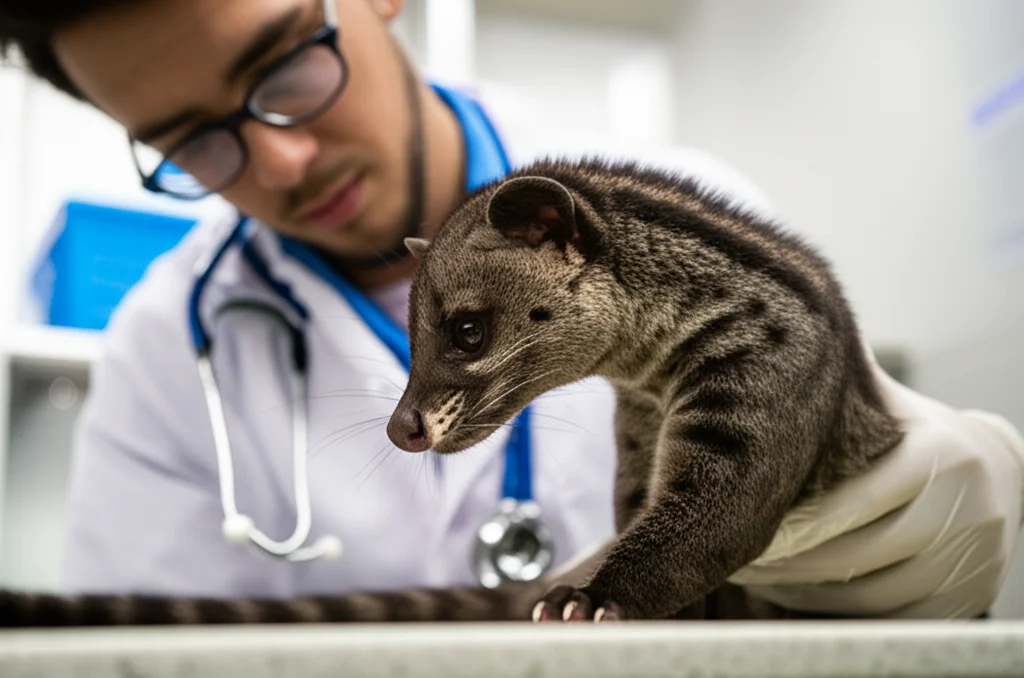Singapore’s Urban Wildlife Holds a Secret: Meet a Brand New Parasite!
Hey there! Ever wondered what kind of tiny critters are hitching a ride on the wildlife living right alongside us? Especially in a bustling place like Singapore, where urban spaces and nature often bump right into each other? Well, I’ve got some pretty cool news about a recent discovery involving those fascinating common palm civets you might occasionally spot.
These civets, known scientifically as Paradoxurus musangus, are pretty adaptable. They’ve figured out how to make a living even in built-up areas, which is neat but also means they’re living super close to people and our pets. This got some folks thinking: what kind of bugs or germs might they be carrying that could potentially spread?
We know a bit about the bacteria and viruses civets can carry – some are even linked to human health concerns, like the masked palm civets and SARS back in the day. But when it comes to tiny blood parasites called piroplasms? Not so much. Piroplasms are a diverse bunch, including well-known genera like Babesia and Theileria, and they’re often spread by ticks. They’re super common blood parasites in mammals globally, and wild animals can be important reservoirs.
So, we decided to take a closer look at the common palm civets in Singapore. We wanted to see if they were harbouring any of these piroplasms and, if so, what they were.
What We Did
Over two years, we got the chance to check out 135 wild common palm civets that were part of rescue and release operations. It was a great opportunity to get a peek into their health! We recorded their sex and weight, and if we found any external parasites (like fleas or ticks), we collected them for identification. Most importantly, we took blood samples.
We used some pretty standard lab techniques – DNA extraction from the blood and a special test called PCR to look for the DNA signature of piroplasms, specifically targeting a gene called 18S rRNA. If a sample was positive, we did more tests to get a longer sequence of that gene so we could figure out exactly *what* piroplasm it was and how it relates to others. We also looked at blood smears under a microscope to see what the parasites looked like inside the blood cells.

The Big Reveal: A Brand New Bug!
Turns out, our civet friends *are* carrying piroplasms! We found a novel *Cytauxzoon* species in 29 of the 135 civets we sampled. That’s about 21.5% – roughly one in five civets we checked had this parasite. This is actually the very first time a *Cytauxzoon* species has been confirmed molecularly in Southeast Asia, and the first time one has been reported in an animal from the Viverridae family (that’s the civet family!).
We didn’t see any big difference in infection rates between 2022 and 2023, which might suggest this parasite is pretty established in the local civet population.
Who’s Got It?
One interesting thing we noticed was a statistically significant link between infection and the civet’s weight. Basically, heavier civets were more likely to be infected. Since weight and age are often related in animals, this hints that the parasite is probably something they pick up over time, rather than something passed down from mum. It could be that older/heavier animals have had more time to be exposed, or maybe their larger size makes them bigger targets for whatever is spreading the parasite.
We didn’t find any significant link between infection and the civet’s sex or the month we sampled them.
What Does It Look Like?
Looking at the infected blood under the microscope was pretty cool (in a science kind of way!). We saw tiny little dots, about 1-2 micrometers across, inside the red blood cells. They had a dark spot (the nucleus) off to one side and a pale body. The number of infected red blood cells was pretty low, less than 1%, and we didn’t see any of the parasite stages that hang out in other cells like monocytes. This low level of infection and lack of obvious signs in the civets is actually quite telling, as we’ll see later.

Where Does It Fit In?
The genetic analysis of the parasite’s 18S rRNA gene sequence was key. When we compared it to known *Cytauxzoon* species in genetic databases, it didn’t match anything exactly. The closest match was to an unclassified *Cytauxzoon* found in meerkats in South Africa, but it was still quite distinct. It was even more different from *Cytauxzoon felis*, the species famous for causing severe disease in domestic cats (though it’s relatively mild in its natural host, the bobcat).
Based on the genetic differences and how it clustered in the phylogenetic ‘family tree’ we built, plus some fancy species delimitation analysis, the evidence strongly supports this as a *new* species. So, we’ve officially named it Cytauxzoon paradoxurus n. sp., after the genus of its host, Paradoxurus. Pretty fitting, right?
This is a significant finding because, before this, *Cytauxzoon* infections had only really been reported in cats (like domestic cats, bobcats, and others), meerkats, and bears. Finding it in a civet expands our understanding of which animals can host these parasites.
The Mystery Vector
Now, here’s a puzzle: *Cytauxzoon* species are typically spread by ticks. But despite checking the civets carefully, we didn’t find *any* ticks on them! This means we still don’t know for sure how C. paradoxurus is being transmitted.
We did find cat fleas (Ctenocephalides felis) on two of the civets, which is interesting because it shows potential interaction between civets and domestic animals (cat fleas are common on pet cats and dogs). However, we tested these fleas and didn’t find any *Cytauxzoon* DNA in them, so they don’t seem to be the culprit.
Why no ticks?
- Maybe the urban environment the civets live in isn’t ideal for ticks.
- Civets are known to be pretty good groomers, which helps them remove ticks.
- The vector could be something else entirely, or a tick species we didn’t find.
More research is definitely needed to figure out the transmission route!

Why Should We Care?
Okay, so we found a new parasite in civets. Why is this important?
Firstly, the fact that the infected civets didn’t seem obviously sick is a big clue. This is similar to how *C. felis* behaves in its natural host, the bobcat – it causes a mild, chronic infection. This suggests that common palm civets might be the natural host for C. paradoxurus. Natural hosts often carry the parasite without getting severely ill, acting as reservoirs.
However, the danger comes when a parasite jumps to a *maladapted* host – an animal that hasn’t evolved with the parasite and doesn’t have a good immune response. Think about *C. felis* jumping from bobcats to domestic cats. In domestic cats, *C. felis* infection is often severe and life-threatening, with high fatality rates even with treatment.
Since common palm civets live so close to humans and our pets in Singapore, there’s a potential risk of C. paradoxurus crossing over. While there are no reports of *Cytauxzoon* infecting humans, the possibility of it spreading to domestic animals, particularly cats, is a concern. Imagine if this new species caused severe disease in pet cats like *C. felis* does!
This highlights just how crucial biosurveillance is. By studying the pathogens in wildlife, especially those living near us, we can get ahead of potential problems. We need to keep an eye on these wildlife-domestic animal interfaces to understand the risks and try to prevent any spillover events.

Wrapping Up
So there you have it! We’ve discovered and described Cytauxzoon paradoxurus n. sp., a novel parasite living in common palm civets in Singapore. It’s the first *Cytauxzoon* found in a civet and the first molecular confirmation in Southeast Asia. While the civets seem to handle it okay, its presence in animals living so close to our homes is a reminder that we need to keep studying these connections.
There’s still lots to learn – especially about how this new parasite spreads. But this discovery is a big step in understanding the hidden world of parasites in our urban wildlife and the potential implications for animal health all around us.
Source: Springer






